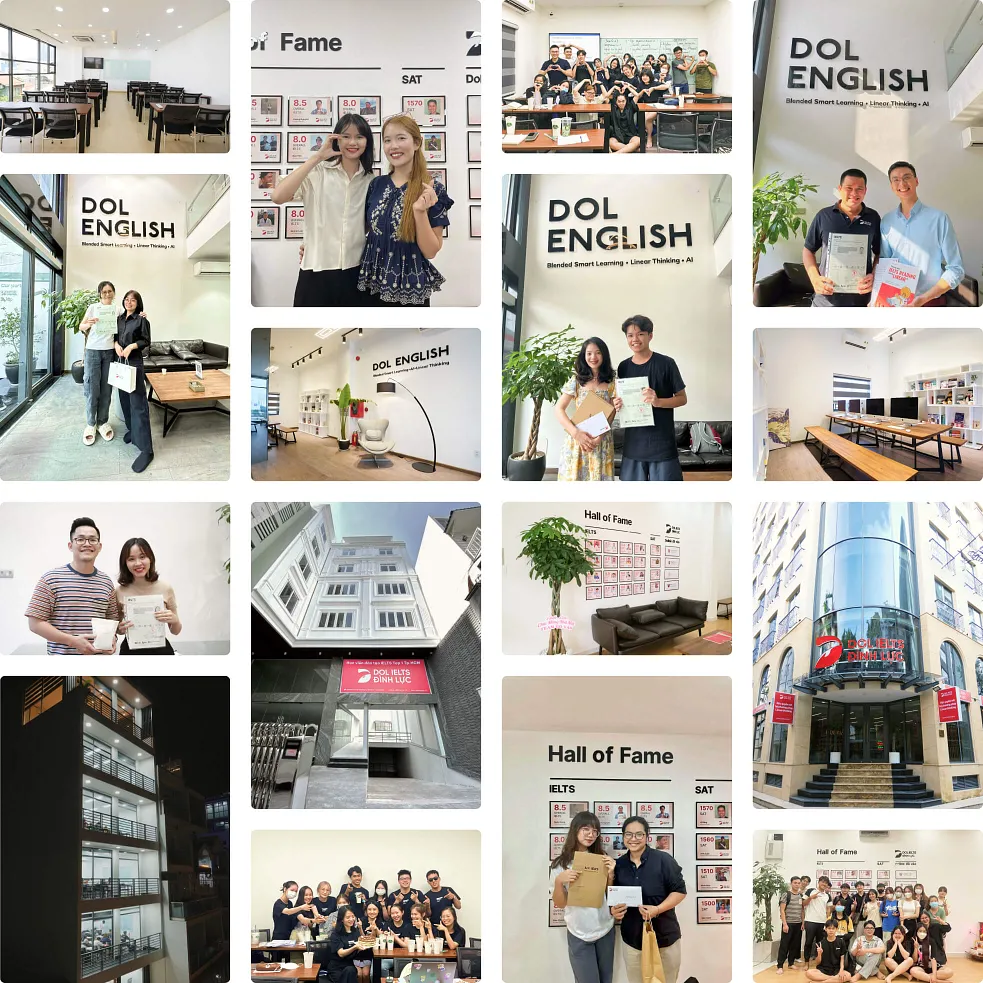Cách viết IELTS Writing Task 1 chi tiết cho người mới bắt đầu
IELTS Writing Task 1 là dạng bài yêu cầu bạn tóm tắt và miêu tả các dữ liệu được trình bày dưới dạng biểu đồ, bảng biểu, quy trình và bản đồ. Phần thi đánh giá khả năng của bạn trong việc phân tích và hiểu dữ liệu, sử dụng từ vựng chính xác khi mô tả bảng biểu và sắp xếp dữ liệu một cách logic.
Trong bài viết này, DOL sẽ hướng dẫn chi tiết cách viết bài IELTS Writing Task 1 hiệu quả cho người mới bắt đầu, bao gồm: Phân tích đề bài, Lập dàn ý, Viết phần Introduction, Overview, Details. Bài viết cũng đề cập đến một số lưu ý quan trọng khi viết bài, cũng như các bài mẫu và từ vựng thường gặp để hỗ trợ việc luyện tập cho phần thi IELTS Writing Task 1.
Hãy tiếp tục đọc để cùng DOL khám phá bí kíp "vượt ải" Task 1 thành công!
DOL IELTS Đình Lực
May 22, 2024
5 mins read
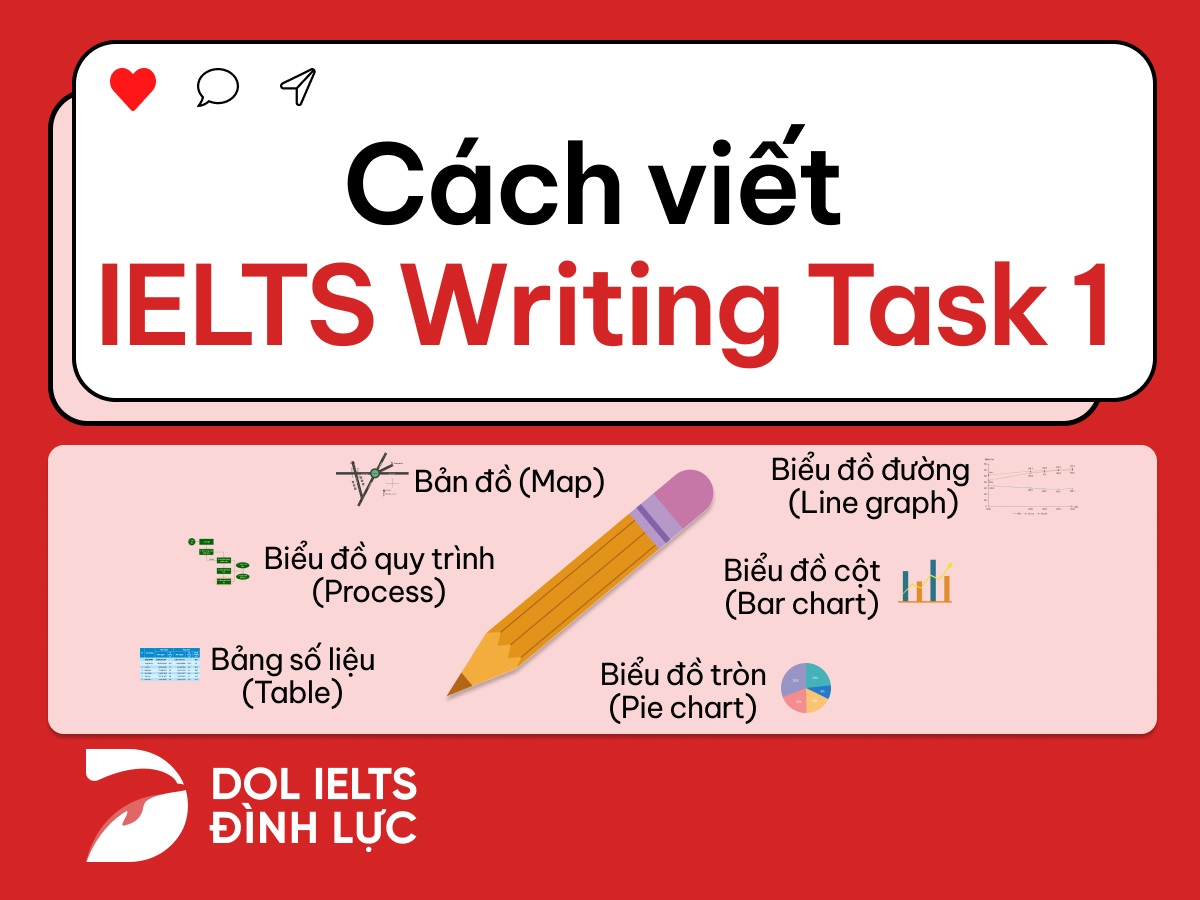
Table of content
Sơ lược về IELTS Writing Task 1
Bước 1: Phân tích đề
Bước 2: Lập dàn ý
Bước 3: Hướng dẫn viết Introduction
Bước 4: Viết Overview - Phần tổng quan
Bước 5: Viết Detailed Body Paragraphs - Phần thân bài chi tiết
Lưu ý khi luyện viết IELTS Writing Task 1
Bài mẫu Writing IELTS Task 1
Câu hỏi thường gặp
Sơ lược về IELTS Writing Task 1
IELTS Writing Task 1 là dạng bài yêu cầu thí sinh phải tóm tắt và miêu tả dữ liệu ở nhiều dạng biểu đồ khác nhau như biểu đồ đường, biểu đồ cột, quy trình, bảng biểu,…
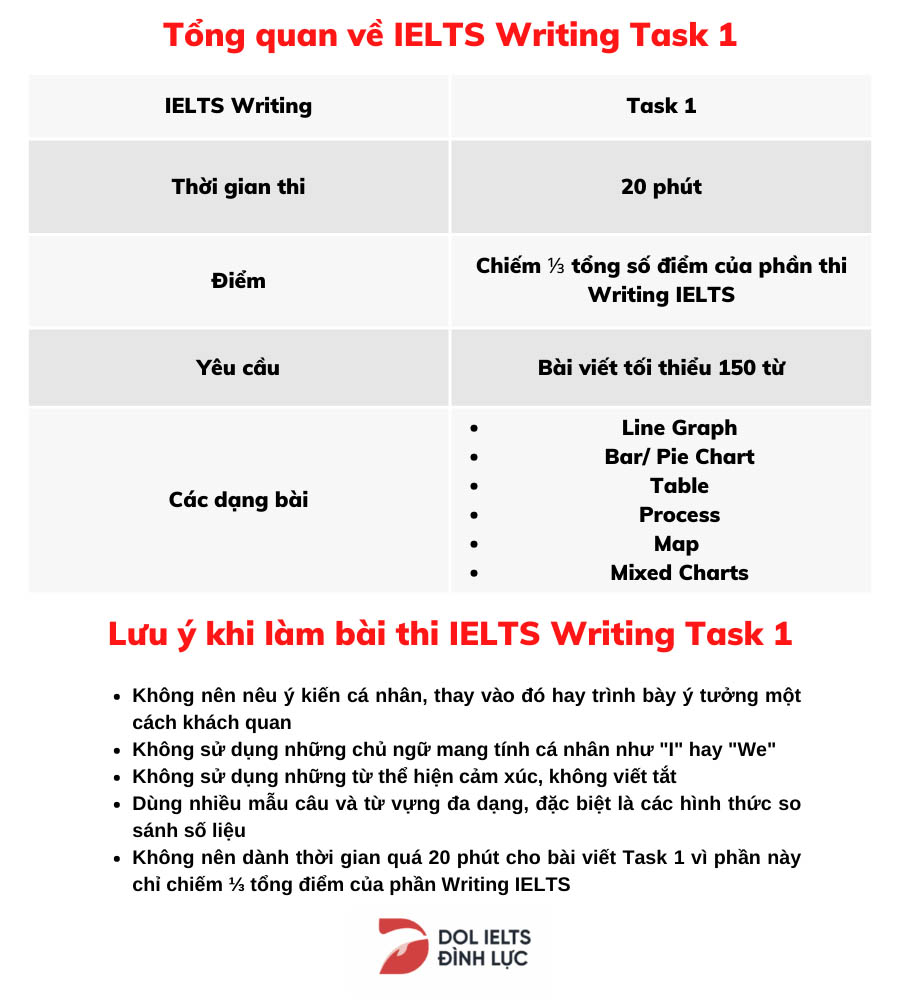
Bài thi sẽ được đánh giá dựa trên 4 tiêu chí chấm điểm Writing IELTS Task 1 sau, mỗi tiêu chí chiếm 25% số điểm.

Tìm hiểu thêm về Band Descriptors IELTS Writing Task 1 trong tài liệu sau đây!
Dựa vào tiêu chí chấm điểm để ôn luyện Writing task 1 đạt band 9 dễ dàng.
Cách viết IELTS Writing Task 1
Introduction | (1 - 2 câu) | Giới thiệu sơ lược về biểu đồ nói về cái gì |
Overview | (1 - 2 câu) | Đưa ra những đặc điểm nổi bật nhất của biểu đồ |
Detail 1 | (4 - 5 câu) | Miêu tả số liệu chi tiết của biểu đồ |
Detail 2 | (4 - 5 câu) | Miêu tả số liệu chi tiết của biểu đồ |
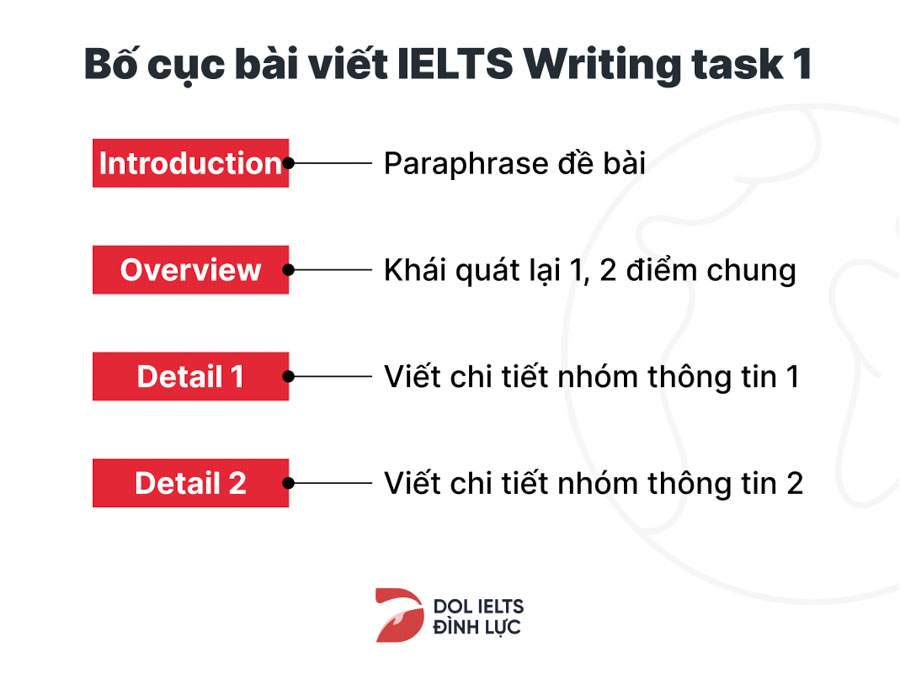
Lưu ý: Bài phân tích biểu đồ trong Task 1 không cần có conclusion vì phần overview đã đóng vai trò tóm tắt nội dung chính của biểu đồ rồi
Để hoàn thành phần thi IELTS Writing Task 1 dễ dàng, cần nắm rõ 5 bước sau đây.
Phân tích đề IELTS Writing Task 1
Lập dàn ý cho bài thi IELTS Writing Task 1
Viết Details IELTS Writing Task 1
Cùng DOL đi vào chi tiết từng bước thực hiện bài thi IELTS Writing Task 1 nhé!
Bước 1: Phân tích đề
Nhiều bạn thường bỏ qua việc phân tích đề bài trước khi viết. Thói quen này có thể khiến bản thân bỏ lỡ những thông tin quan trọng trong bài. Để tránh điều này, trước khi bắt tay vào viết, hãy tự đặt cho mình những câu hỏi sau.
Biểu đồ này thể hiện nội dung gì?
Có bao nhiêu hạng mục hoặc đối tượng cần phân tích?
Biểu đồ có bao nhiêu mốc thời gian?
Cần sử dụng loại biểu đồ nào cho đề bài này?
Đơn vị được sử dụng trong biểu đồ là gì?
Biểu đồ có xu hướng thay đổi tăng/giảm không?
Bước 2: Lập dàn ý
Dàn ý cho bài thi IELTS Writing Task 1 là một bước quan trọng để tổ chức thông tin và ý tưởng của bạn một cách rõ ràng và mạch lạc.
Dưới đây là cách lập dàn ý cho bài thi này.
Đoạn 1: Introduction (1-2 câu giới thiệu sơ lược về biểu đồ nói về cái gì)
Đoạn 2: Overview (1-2 câu đưa ra những đặc điểm nổi bật nhất của biểu đồ)
Đoạn 3 và 4: Details (4-5 câu mỗi đoạn miêu tả số liệu chi tiết của biểu đồ)
Bước 3: Hướng dẫn viết Introduction
Trong phần Introduction, bạn chỉ cần viết 1 - 2 câu trình bày nội dung của biểu đồ và những mốc thời gian lớn cần lưu ý bằng phương pháp paraphrase (diễn đạt lại đề bài theo một cách khác nhưng vẫn giữ ý nghĩa gốc).
Cấu tạo của một câu Intro Task 1:
Tên biểu đồ + động từ (shows/illustrates..) (that) + đối tượng trong bài + địa điểm + mốc thời gian
Ví dụ: The bar chart gives information about the price of tickets on one airline between Sydney and Melbourne, Australia, over a two-week period in 2013.
Lưu ý
Thí sinh đừng bị phụ thuộc quá nhiều vào từ vựng khi paraphrase, nếu không khi gặp đề tài lạ sẽ không viết được phần Introduction.
Nên sử dụng tư duy Linearthinking để paraphrase cấu trúc hơn là chỉ paraphrase từ vựng.
Dưới đây là một số phương pháp viết một Introduction IELTS Writing hiệu quả.
1 Sử dụng từ đồng nghĩa
Bạn có thể sử dụng các cụm dưới để bắt đầu luyện tập viết mở bài.
Những từ thể hiện biểu đồ được đề bài cho: The given... / The supplied... / The presented... / The shown... / The provided...
Những từ chỉ tên biểu đồ: Diagram / table / graph / chart / picture/ pie chart / bar graph/ line graph / process/ map
Động từ nói về nội dung của biểu đồ: Shows/ represents/ illustrates/ presents/ gives/ provides/ describes/ compares/ shows contrast / indicates/ gives data on/ gives information on/ demonstrates
Đối tượng chính của biểu đồ: Đề bài ⇒ Paraphrase
the number of ⇒ how many/the figure/the data
the amount of ⇒ how much/the figure/the data
the percentage of ⇒ the proportion/the figure/the data
parents ⇒ fathers and mothers/mom and dad
salary ⇒ income/earnings
expenditure ⇒ expense
boys and girls/men & women ⇒ males and females
Những cụm từ chỉ thời gian: Đề bài ⇒ Paraphrase
From 2000 to 2010 ⇒ Between 2000 and 2010/ During a period of 10 years/ During a 10-year period
In 1990, 2000 and 2010 ⇒ In three different years
Until 2030 ⇒ Up to 2030
every day/ week / month / year ⇒ daily / weekly / monthly / yearly = annually
2 Thay đổi cấu trúc câu
Bạn có thể sử dụng paraphrase lại đề bài bằng cách thay đổi cấu trúc câu như sau.
 Thay đổi từ chủ động sang bị động và ngược lại
Thay đổi từ chủ động sang bị động và ngược lại
Đề bài: The line graph shows the global demand for different textile fibers between 1988 and 2016. ⇒ Introduction: The line graph illustrates the total number of fibers that are needed all over the world from 1988 to 2016.
 Chuyển danh từ thành động từ ở dạng Process và Map
Chuyển danh từ thành động từ ở dạng Process và Map
Đề bài: The maps below show the changes in an Art Centre from 2010 to today. ⇒ Introduction: The illustration shows how the internal layout of an Art Center changed from 2010 to the present.
Đề bài: The diagram below shows the process of making soft cheese. ⇒ Introduction: The diagram below shows how to produce soft cheese.
3 Sử dụng mệnh đề quan hệ who, which, that
Đề bài: The table with the percentage of students in six different departments in 2011. ⇒ Introduction: The given table illustrates data on different aspects of undergraduates who took six different majors at an Australian University in 2011.
_
Dưới đây là một số lưu ý quan trọng khi viết phần Introduction.
Tránh đưa ra các số liệu cụ thể trong phần Giới thiệu, ngoại trừ thông tin liên quan đến năm.
Không nên thể hiện quan điểm cá nhân hoặc kiến thức đã biết trong việc phân tích số liệu.
Không cần dành quá nhiều thời gian cho phần Giới thiệu.
Trong trường hợp biểu đồ là dạng Biểu đồ hỗn hợp, bạn nên viết 2 câu trong phần Giới thiệu, mỗi câu tương ứng với một loại biểu đồ.
Bước 4: Viết Overview - Phần tổng quan
Phần mô tả chung Overview đóng vai trò tóm tắt những điểm nổi bật hay xu hướng chung của biểu đồ, giúp người đọc nắm được ý chính của các con số hay hình ảnh. Bạn có thể đặt phần overview ở phần đầu hoặc cuối bài nhưng phổ biến nhất sẽ là đặt overview ngay sau câu mở đầu.
Một số lưu ý chính khi viết phần Overview.
Sử dụng cụm từ nối dưới đây để mở đầu phần Overview.
In general,...
Overall,...
It is obvious/ clear that...
As can be seen that...
An overall trend can be seen is that...
It can be clearly seen that...
What is notable from the chart is that...
Khi viết Overview, bạn cần trả lời được những câu hỏi dưới đây
Điểm nổi bật nhất của biểu đồ là gì?
Điểm nào lớn nhất hay nhỏ nhất?
Xu hướng biểu đồ hiện tại đang là gì?
Các mốc thời gian đang có là gì? Điều gì thay đổi qua từng mốc?
Điểm tương đồng và khác biệt giữa các biểu đồ là gì?
Chủ đề yêu cầu các từ vựng loại nào?
Lưu ý:
Không được đưa ý kiến cá nhân vào phần Overview nói riêng hay cả bài viết IELTS Writing Task 1 nói chung bạn nhé!
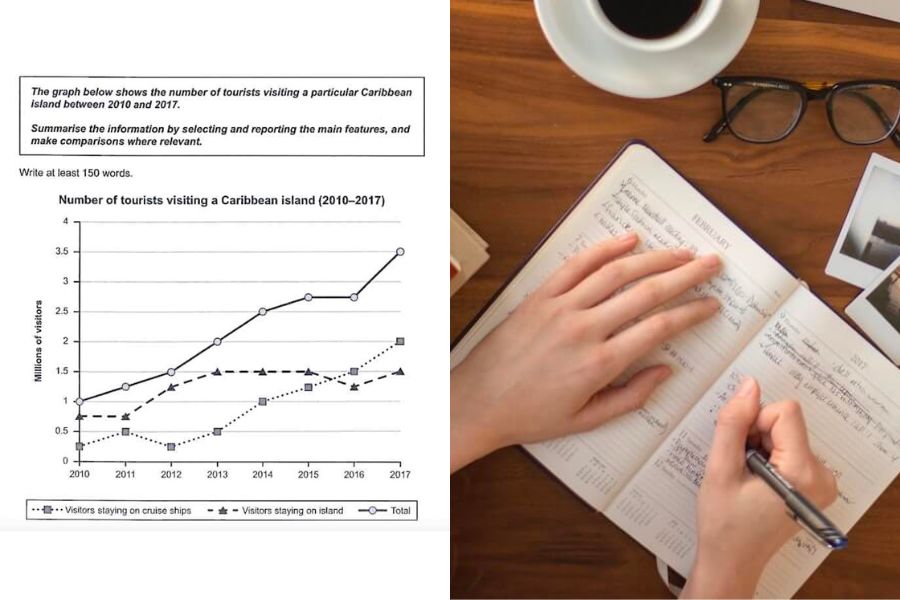
Bước 5: Viết Detailed Body Paragraphs - Phần thân bài chi tiết
Thân bài là phần mà bạn cần phân tích chi tiết xu hướng hoặc sự thay đổi trong bảng/biểu đồ. Ở đây bạn cần chọn lọc các điểm thông tin chính của biểu đồ và nêu số liệu cụ thể.
Nên cố gắng nhóm các thông tin nổi bật như tương đồng hoặc trái ngược xu hướng với nhau. Đừng cố gắng nêu mọi thông tin bằng cách liệt kê hết tất cả dữ liệu bạn nhé!
Thông thường, tổng phần thân đoạn sẽ có từ 6 đến 8 câu, mỗi đoạn tầm 3-4 câu. Bạn có thể viết nhiều hơn tuy nhiên nên tránh viết dài lan man sẽ bị nhầm sang phân tích chi tiết biểu đồ.
Đối với phần này, bạn nên cố gắng thực hiện các công việc sau tùy theo từng dạng biểu đồ.
Nếu đề là dạng biểu đồ, bạn nên nhóm các thông tin tương đồng hoặc trái ngược xu hướng nhau;
Nếu đề là dạng Process, bạn cần phân chia hợp lý một quá trình thành 2 giai đoạn chính (đoạn 1 là sơ chết đoạn 2 là về đóng gói);
Nếu đề là dạng Map, bạn có thể phân chia phân tích sự thay đổi theo các hướng Đông, Tây, Nam, Bắc.
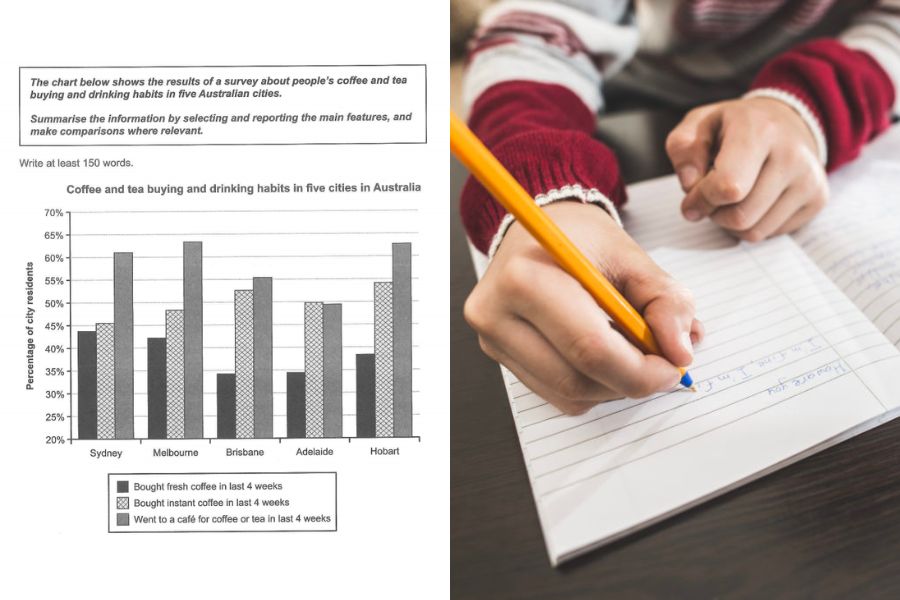
Cụ thể, bạn cần đặt ra những câu hỏi sau khi chia đoạn thân bài.
 Dạng biểu đồ
Dạng biểu đồ
Xu hướng hoặc chuyển động tương đồng giữa các yếu tố là gì?
Có thể nhóm từng đoạn theo mốc thời gian không?
Với bài không có thời gian cụ thể, các yếu tố giống nhau ở những điểm nào?
Với Mixed Charts chỉ có 2 Charts, mỗi đoạn có thể miêu tả 1 biểu đồ hay nên miêu tả các xu hướng tương đồng giữa các biểu đồ
Với đề bài có nhiều hơn 2 Charts, đoạn 1 nên nhóm những xu hướng tương đồng nào? Thông tin gì có thể nhóm chung cho đoạn 2?
 Dạng Process
Dạng Process
Nên chia Process ra làm bao nhiêu phần? Phần nào ở đoạn 1 và phần nào ở đoạn còn lại?
Các bước nào của Process có thể được nhóm chung với nhau dựa trên các đặc điểm đặc thù của Process?
 Dạng Map
Dạng Map
Có bao nhiêu khu vực?
Có thể chia các khu vực làm 2 đoạn không?
Những thay đổi chính của khu vực là gì theo thời gian?
Những điểm có thể nhóm chung của khu vực là gì?
Lưu ý:
Khác với Overview, bạn cần nêu số liệu và thời gian cụ thể cho các đoạn Detailed.
Đừng quên sử dụng các từ nối (Connecting Words) để chuyển ý nhé.
Hãy trình bày theo trình tự thời gian.
Một số từ vựng cho đoạn mở đầu phần Body Detailed mà bạn có thể tham khảo để viết tốt hơn.
According to the...
Now, turning to the details...
As the diagrams suggest...
As it is presented in the diagram(s)/ graph(s)/ pie chart(s)/ table...
The graph gives the figure...
It is apparently seen that...
The table data clearly shows that...
Categorically speaking...
It is interesting to note that...
It is conspicuous that...
It is clear from the data...
It can be clearly observed that...
It could be noticed that...
The diagram reveals that...
It is worth noticing that...
It is explicitly observed that...
Getting back to the details...
The data suggest that...
As (it is) shown in the illustration...
It is obvious...
It could be plainly viewed that...
We can see that...
As can be seen in the...
It is crystal clear/ lucid that...
Ví dụ
It is obvious that the first stage revolves around the collection of raw materials, in which the sheep are raised until they are matured enough to produce a thick layer of fur. The fur is then sheared and cleaned using water in order to remove dirt prior to the manufacturing stages. Having been clean, the wet fur is then transferred into a drying machine to soak up excess moisture. After that, the dried fur is carded with a wire instrument. This special tool brushes the wool straight and woven them into a single strand.
We can see that in week 1, airfares from Sydney to Melbourne began at $80 on Monday and remained under $40 for the following three days before rising to $75, $70, and $50, respectively, on Friday, Saturday, and Sunday. The costs remained the same during the second week, with the notable exception of a drop on Monday to $50.
It is apparently seen that most females were in favor of humanities majors (72%) and the educational sector (68%). While there were slightly more than half of this population studied Science and Physics (52% and 56%, respectively), they seemed less appealing to technological majors such as information technology and engineering which accounted for roughly 15%.
It could be noticed that Germany and Switzerland had the highest percentage of males and females having higher education qualifications. In addition, the percentage of women holding degrees in higher education in Japan was the lowest among the surveyed categories.
As can be seen in the initial stage, whole beans are selected from the picking up process before being dried to extract their shell.
Cùng DOL áp dụng cách chia đoạn vào một bài biểu đồ sau.
Đề bài: The chart below shows the results of three surveys on absenteeism in a particular European country in the years of 2000, 2005 and 2010.
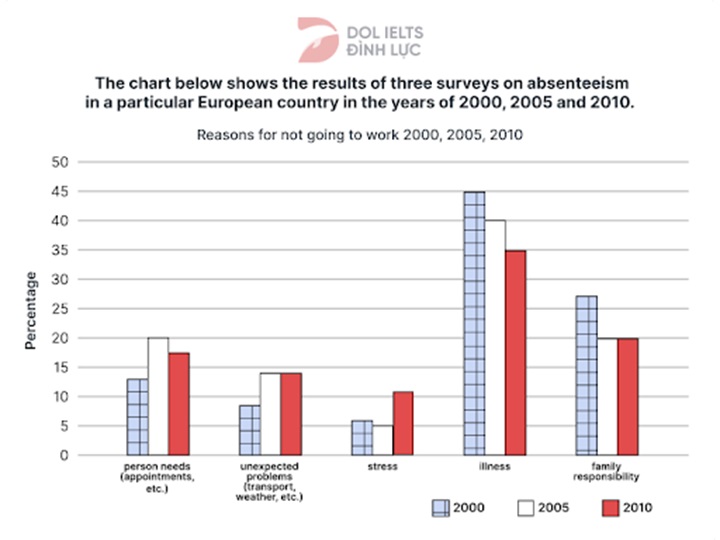
Biểu đồ trên có ba mốc thời gian. Do đó đây là dạng Graph with Trend.
Đối với dạng bài này Đoạn 1 sẽ là đoạn về năm đầu tiên và Đoạn 2 mô tả trend (sự thay đổi của hai năm còn lại)
Đoạn 1: In 2000
Illnesses: 45% >>> exceed family responsibility by 20%;
Personal needs: 13%;
Unforeseen problems and stress: below 10%.
Đoạn 2: Các năm còn lại (Bắt đầu bằng Thereafter/Afterward)
Health & family matters: declining to 35% and 20% respectively in 2010;
Unexpected issues & stress: an opposing pattern (14% and 11%) in 2010;
Personal appointments: a peak of 20% in 2005 >>> a marginal decline of 3% (2010).
Thân bài mẫu 8.0 của DOL.
In 2000, illnesses accounted for 45% of the total reasons, exceeding the figure for family responsibility by roughly 20%. This was followed by personal needs, at around 13%, while the figures for unforeseen problems and stress were negligible, both occupying below 10%.
Thereafter, absenteeism due to health and family matters observed a decrease, declining to 35% and 20% respectively in 2010. Unexpected issues and stress displayed an opposing pattern, with corresponding figures being approximately 14% and 11% by the end of the period. Absences for personal appointments and similar needs reached a peak of 20% in 2000 before experiencing a marginal decline of 3% over the subsequent five years.
Dựa vào các viết chung cho phần thi Writing Task 1, DOL xin chia sẻ chiến lược viết các dạng bài IELTS Writing Task 1 xuất hiện trong bài thi sẽ bao gồm 7 loại biểu đồ chính.
Line Graph - Dạng biểu đồ đường
Bar Chart - Dạng biểu đồ cột
Pie Chart - Dạng biểu đồ tròn
Table - Dạng bảng số liệu
Mixed Charts/ Graphs - Dạng biểu đồ kết hợp
Process - Dạng quy trình
Mỗi dạng bài yêu cầu bạn sử dụng các kỹ năng khác nhau để tóm tắt và miêu tả dữ liệu một cách hiệu quả.
Lưu ý khi luyện viết IELTS Writing Task 1
Để bài viết Writing IELTS Task 1 đạt số điểm cao trong kỳ thi thì bạn nên tránh các lỗi phổ biến khi làm bài tập IELTS Writing Task 1.
Bài viết đạt chuẩn: Tối thiểu 150 chữ, thể hiện đầy đủ nội dung đề bài.
Quản lý thời gian hiệu quả: Hoàn thành bài thi trong 20 phút, đảm bảo sự tập trung và tốc độ.
Tóm tắt thông tin: Overview đóng vai trò tóm tắt nội dung chính của biểu đồ, không cần viết conclusion.
Tính khách quan: Tránh đưa ra nhận xét hoặc ý kiến cá nhân, sử dụng ngôi thứ ba để miêu tả dữ liệu.
Lựa chọn thông tin: Chọn lọc những chi tiết/xu hướng chính, không mô tả tất cả số liệu.
Sử dụng ngôn ngữ trang trọng: Tránh viết tắt, sử dụng từ ngữ trang trọng và phù hợp ngữ cảnh.
Để miêu tả chiều hướng thay đổi của một đối tượng, bạn có thể áp dụng những từ vựng IELTS Writing Task 1 thường gặp trong bài thi.
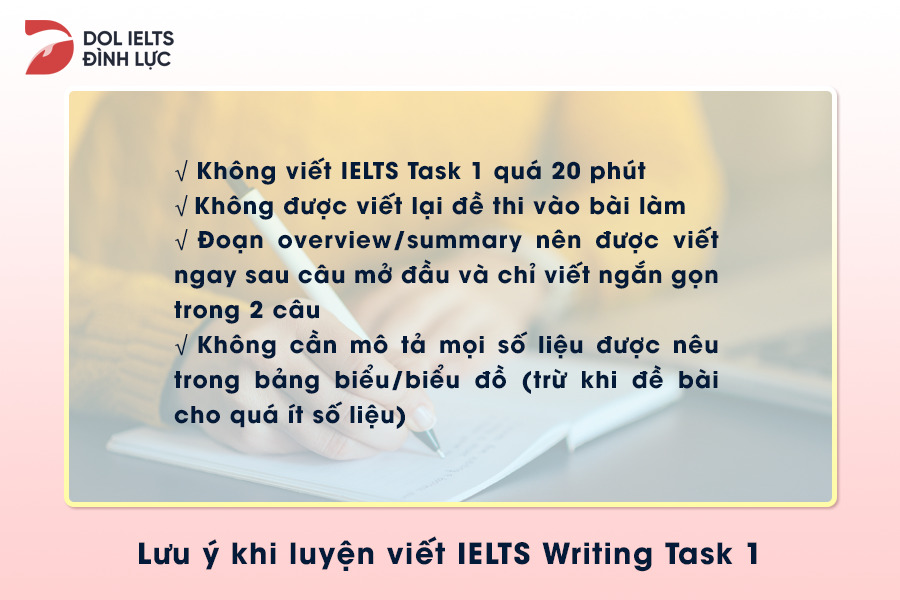
Hãy chắc chắn rằng bạn luyện viết các bài luận mẫu nhiều lần để cải thiện kỹ năng Viết IELTS Task 1 của mình. Chỉ sao chép mẫu một lần sẽ không giúp được gì nhiều - Bạn sẽ cần thực hành những kỹ năng đó nhiều lần để thực sự hoàn thiện chúng
https://magoosh.com/ielts/ielts-academic-writing-task-1/
Bạn có thể xem thêm cách để viết bài IELTS hay bất cứ bài luận nào trong video dưới đây!
Bài mẫu Writing IELTS Task 1
1 Chủ đề Line Graph - Biểu đồ đường
Average Japanese month salary and the prices of black - white TVs & color TVs
2 Chủ đề Bar chart - Biểu đồ cột
Population in the UK who consumed the daily amount of fruit and vegetables
3 Chủ đề Pie chart - Biểu đồ tròn
The maps show how the industrial area will change into a housing area in the future
4 Chủ đề Table - Bảng số liệu
Data about what people in the UK thought the government should increase spending on
5 Chủ đề Map - Bản đồ
IELTS Writing Task 1 Wool Making Process ngày 26/02/2022
6 Chủ đề Process - Quy trình
Đề thi IELTS Writing Task 1 ngày 08/07/2023 kèm bài mẫu band 8
7 Chủ đề Mixed Charts/ Graphs - Biểu đồ kết hợp
Water consumption in Australia - IELTS Writing Task 1 Sample
Bạn có thể tham khảo thêm về các dạng bài IELTS Writing Task 1 trong tài liệu sau đây!
Câu hỏi thường gặp
Cần chú ý những gì khi viết phần mở bài Writing IELTS Task 1?
Viết phần mở bài ngắn gọn, không đi sâu vào từng đặc điểm chi tiết
Không sao chép lại câu hỏi đề bài
Không trình bày những thông tin không liên quan
Không thay đổi các từ khóa quan trọng trong đề bài thành những từ đồng nghĩa không chính xác
Gợi ý 1 số từ vựng nên ứng dụng vào Writing IELTS Task 1
Từ vựng mô tả xu hướng tăng lên: Climb (past: climbed); go up (past: went up); grow (past: grew); increase (past: increased); jump (past: jumped); rise (past: rose); rocket (past: rocketed)
Từ vựng mô tả xu hướng giảm xuống: Decline (past: declined); decrease (past: decreased); drop (past: dropped); fall (past: fell); go down (past: went down); plummet (past: plummeted); plunge (past: plunged)
Từ vựng mô tả xu hướng ổn định: Maintain (past: maintained); remain (past: remained); stay (past: stayed); constant; stable; steady; unchanged
Gợi ý 1 số cấu trúc ngữ pháp dùng cho Writing IELTS Task 1
There + be + a/ an + adj + Noun
S + see/ experience/ undergo + adj + Noun A + adj + Noun + in + S be recorded
Qua bài viết này chắc hẳn các bạn đã có cái nhìn tổng quát về những dạng bài trong IELTS Writing Task 1. Cùng với đó là cách viết IELTS Writing Task 1 đối với từng dạng bài rồi đúng không nào? Chúc các bạn có chiến lược viết IELTS Task 1 thật hiệu quả.
Table of content
Sơ lược về IELTS Writing Task 1
Bước 1: Phân tích đề
Bước 2: Lập dàn ý
Bước 3: Hướng dẫn viết Introduction
Bước 4: Viết Overview - Phần tổng quan
Bước 5: Viết Detailed Body Paragraphs - Phần thân bài chi tiết
Lưu ý khi luyện viết IELTS Writing Task 1
Bài mẫu Writing IELTS Task 1
Câu hỏi thường gặp


